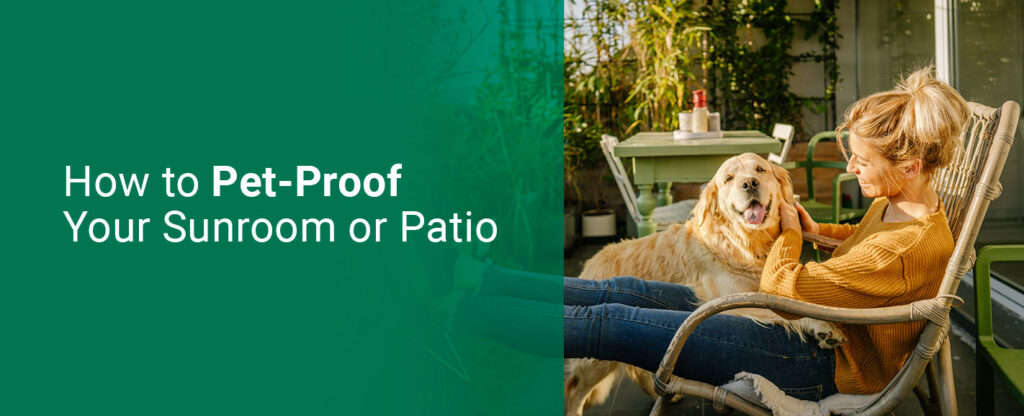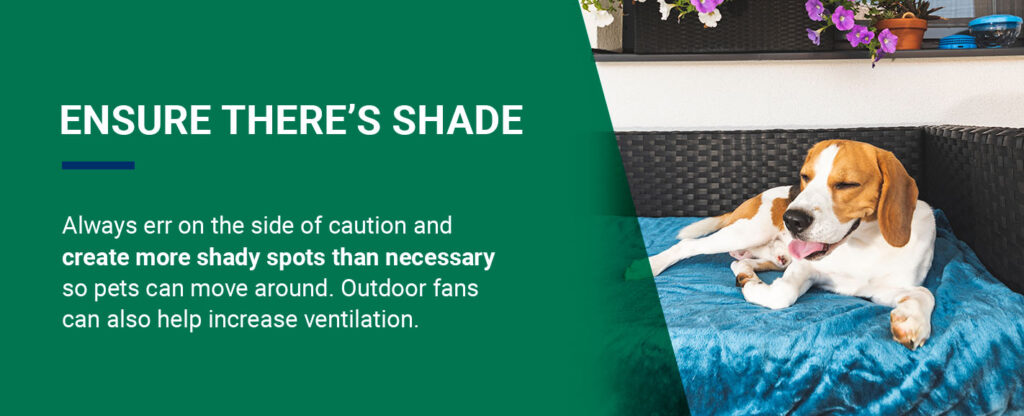
Though our pets are intelligent, they don’t ask questions or think about danger like humans do. Living with a pet is a little like having a permanent toddler. As your pet’s guardian, it’s your responsibility to protect them from things they don’t understand by pet-proofing your home. Animals are curious, and they like to explore new places and chew new things. With some preparation, you can ensure your sunroom and patio are safe places where your pet can enjoy living.
How to Pet-Proof a Sunroom
Sunrooms are a favorite spot for pets because of the abundant sunshine streaming through the windows. Many people fill these rooms with plants, comfy seating and bookshelves so they can use the space to unwind. These pet-proofing ideas for your sunroom will ensure your pet can safely enjoy the area with you.
Eliminate Potential Toxins
Unfortunately, many plants are toxic to pets if ingested. If your pets like to chew on leaves or play with your plants, you need to be careful about what they have access to. Here are a few plants that can be toxic to pets if eaten:
- Peace lilies
- Aloe vera
- Monstera deliciosa
- Pothos
- Snake plants
Other toxins to consider include chemical coatings on furniture and essential oil diffusers. Some essential oils are toxic to pets when breathed in as a vapor. To ensure your pets stay safe and healthy, keep your sunroom clear of toxic scents and chewable materials.
Keep Pets Cool and Hydrated
Most modern sunrooms have excellent ventilation systems. However, because so much sunshine can enter the room, you must monitor the internal temperature, especially if your pets can move freely in and out of the space.
Keep your animals hydrated with plenty of access to clean water. You should always include a backup water source so they won’t get dehydrated if the first one gets used up or spilled.
Secure Dangerous Items
Pets are lower to the ground and interact with their surroundings differently than we do. Before you let your pet loose in a new space, ensure they can’t get into anything dangerous. Some examples include:
- Electrical cords
- Sewing needles
- Fishing hooks
In addition to picking up hazardous items, you should ensure a curious animal can’t accidentally knock over any furniture or accessories. For example, secure large mirrors to the wall so they can’t fall and hurt your pet. Once you’ve created your pet-proof sunroom, your pets can safely explore to their hearts’ content.
Seal Vents and Screens
Smaller pets may be able to escape down ventilation systems. To prevent them from getting stuck inside your house, securely seal all vents. If you have a larger pet, you may not need to worry about this — though your pet’s foot or snout could still get stuck in an opening.
While many pets enjoy sitting by screened windows, they may get excited and claw the screens. To protect your house and keep your pets from escaping outside, consider keeping all screens securely out of reach or purchase more durable screens.
Choose Pet-Friendly Furniture
Another way to pet-proof your sunroom is to ensure all your furniture is pet-friendly. Like toddlers, pets make messes — they have accidents while potty training, throw up hairballs and may chew on furniture until you teach them to stop.
Pet-friendly furniture should be nontoxic in case pets try to chew on it. It’s also washable, so cleanup is easy and messes don’t ruin anything. Another consideration is maneuverability — if pets fall behind furniture, they should be able to exit safely on their own.
How to Pet-Proof a Patio
If you let your pets explore outside, you should also pet-proof your patio area. Pet-proofing this area is very similar to the ways to pet-proof a sunroom we covered above. However, patios present unique challenges because they’re open to a natural environment.
Ensure There’s Shade

Keep your pets cool if they’re outside for an extended time. Think about shade and ensure your pets can access it when they need to cool off. If you have a fenced patio, there should be enough shade for pets throughout the day.
During hot weather, don’t leave pets outside for too long. Dehydration and overheating can make your pet feel sick. Always err on the side of caution and create more shady spots than necessary so pets can move around. Outdoor fans can also help increase ventilation.
Provide Fresh Water
When animals get overheated, they’ll look for water to drink. If you don’t want your pets drinking out of a dirty puddle, always offer a clean water source. Standing water can lead to bacteria growth, so it’s not the best option for your pets.
Just like indoor water, it’s best to have several options available in case one gets knocked over or used up. To minimize evaporation and make water last longer, put it in the shade. Other animals may drink out of these containers, so it’s best to empty and rinse them when your pets come inside.
Put in Fencing
There are two significant benefits to installing fencing for your pets. First, fencing keeps them safe inside your yard, where you can control what hazards they encounter. However, fencing also keeps other animals out — if you build high enough, your pets should be safe from aggressive dogs.
If you’re worried smaller pets will wander too far, consider installing a catio, a small structure with a mesh enclosure. It allows your pet to enjoy the outdoors without dangerous exposure to the elements. Catios often connect to a door or window so pets can freely enter and exit them.
Avoid Toxic Treats
Just like indoor plants, many outdoor plants are toxic to pets. If your pet tends to chew on or eat leaves, you should check the plants in your yard and remove any that may be toxic to ingest. Though you may be reluctant to move a plant you care about, your pet’s health is paramount.
Some construction materials may also be toxic to pets. For example, wood could have a chemical treatment to preserve its longevity, making it hazardous. You can add coatings to your porch to ensure your pet doesn’t ingest harmful chemicals.
Treat Pets for Pests
Pets who spend time outside can pick up fleas or other pests. If you worry about fleas, ticks or other unwanted critters, check your pets periodically for them. Fleas and ticks tend to be more active during the warmer months.
Though you can’t prevent all pests, you can eliminate them with periodic treatments. Don’t treat your pets unless you see evidence of a pest issue, and always read the instructions carefully. You should spread out some pest treatments over time for your animal’s health.
Bring Sunshine Into Your Home With Garrety Glass

If you want to create a sun-filled oasis for you and your pets, consider adding a sunroom to your home. These spaces bring in sunshine and offer a versatile space to relax, create and connect with nature.
At Garrety Glass, our mission is to connect people through comfortable and beautiful spaces at home. In addition to sunrooms, we build decks and can update windows throughout your home. Contact us today to learn more about our services and how we can help you maximize your living space.